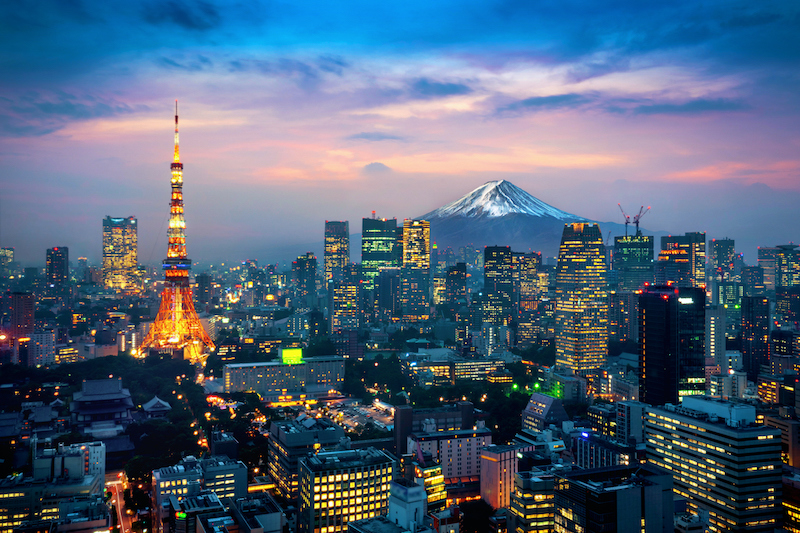
Despite federal attempts to fight COVID-19, Japanese law prioritizes individual rights and regional autonomy.
Two key events have shaped Japan’s response to the novel coronavirus—the Diamond Princess luxury liner that anchored off the coast of Yokohama in early February and the 2020 Summer Olympics. Prime Minister Shinzo Abe, the longest serving prime minister in Japan’s history, led the central government’s handling of those events.
Although Japan is commonly perceived as a nation where a strong state leads a pliable public that is deferential to authority, the most notable aspect of Japan’s coronavirus policy is the priority placed on individual rights over the protection of public health, resulting in a limited lockdown and spotty compliance with requests to stay home and close businesses.
The coronavirus first appeared in Japan aboard the Diamond Princess, a luxury liner that was scheduled to dock in Yokohama on February 3, 2020. Two days before the ship docked, a passenger who had disembarked in Hong Kong tested positive for COVID-19. When a second passenger tested positive for the virus, the Japanese government quarantined the ship. The government did not follow protocols to limit the spread of infectious disease. Passengers remained in their cabins while the crew continued to work and sleep in tight quarters. The supply of personal protective equipment was inadequate. In the end, over 700 passengers and crew tested positive for the virus, making it the second largest coronavirus outbreak in the world, after Wuhan. Japan’s first brush with COVID-19 had not gone well.
The 2020 Summer Olympics, scheduled to begin on July 24 in Tokyo, provided the government with a second opportunity to craft a coronavirus policy. With 600,000 visitors expected to attend and an investment of well over $10 billion, Prime Minister Abe and his economic team were determined to preserve the games.
In the early months of the COVID-19 pandemic, the government limited coronavirus testing to fewer than 2,000 per day. When the International Olympic Committee announced on March 23 that the games would be postponed, however, Japan rapidly increased its testing, administering 8,000 tests on April 9. Predictably, as testing increased so too did the number of positive cases, from an average of 41 cases the week before the Olympic Committee postponed the games, to triple that number the week after the postponement. When the number of positive tests climbed to 400 in early April, it became increasingly clear that the government needed to take decisive action.
For Japanese Prime Minister Shinzo Abe, the adage about never wasting a good crisis could not have been more apt. Unfortunately for Abe, the long and somewhat tangled history of Japan’s infectious disease control laws stymied his ability to take strong executive action to manage the COVID-19 pandemic.
The century-old legal framework for managing infectious diseases in Japan changed dramatically in 1998 with the passage of the Infectious Disease Control Law (IDCL).
When a disease included in the IDCL threatens to spread in Japan, the law gives Japan’s 47 prefectural governors the authority to order medical examinations of suspected patients, prohibit patients from engaging in particular jobs such as restaurant work, compel hospitalization, limit access to potentially contaminated buildings, curtail the movement of infected persons, and more. Because newly discovered diseases are not enumerated in the IDCL, when a new infectious disease surfaces, the Cabinet—the executive branch of Japan’s government—can declare it a “designated infectious disease.” For example, the Cabinet classified SARS and H5N1 avian influenza as designated infectious diseases and added them to the IDCL.
In 2012, the Japanese government responded to the H5N1 avian flu by creating a legal instrument specific to pandemic influenza, the Act on Special Measures for Pandemic Influenza and New Infectious Diseases Preparedness and Response (API). The API allows the Prime Minister to declare a state of emergency if an influenza recognized as an infectious disease by the IDCL is “causing or could cause significant damage to the daily lives of the people and the national economy by rapidly spreading nationwide.”
On January 28, 2020, the Ministry of Health, Labor, and Welfare asked the Prime Minister’s Cabinet to include the novel coronavirus as a designated infectious disease under the IDCL, triggering the provisions of the API. Simultaneously, the Cabinet ordered a revision of the 1951 Quarantine Act by including coronavirus as a quarantinable disease, which gave the government legal cover when it quarantined the Diamond Princess. Two weeks later, another Cabinet order expanded the government’s quarantine authority for the coronavirus, allowing it to isolate asymptomatic individuals who test positive for COVID-19.
Despite the Cabinet’s actions, senior officials raised questions about the scope of the government’s powers under the IDCL and API. Chief Cabinet Secretary Yoshihide Suga, for example, claimed that the IDCL could not be applied to the novel coronavirus because only completely new infectious diseases can be declared designated infectious diseases, and coronaviruses have been around for many years. Japan’s Minister of Health, Labor and Welfare, Katsunobu Kato, echoed this view—along with some legal scholars. In early March, Abe successfully pressed both houses of the Diet—Japan’s legislature—to amend the API to clear up any ambiguity.
Abe has faced continuing criticism of his coronavirus policies, including the Diamond Princess quarantine and his non-binding recommendation in February to cancel large events and close elementary, middle, and high schools. The school closures infuriated many parents and Abe’s critics saw them as an effort to deflect criticism of Abe’s weak approach to testing. On April 6, under pressure from the media and the public, Abe announced a temporary state of emergency that covered seven urban prefectures, which he later expanded to all 47 prefectures and extended until May 31.
A state of emergency may evoke images of isolated streets in Rome, lockdowns in Wuhan, and a desolate Manhattan, but a Japanese-style emergency is a different matter.
Under the amended API, a state of emergency can last for up to two years. Moreover, prefectures included in the declaration must ask residents to exercise “self-restraint” by staying home, can expropriate private land for medical facilities, and are able to require manufacturers and suppliers to sell them essential supplies such as food and medicine.
Unlike lockdowns in other parts of the world, however, the Japanese declaration comes with almost no enforcement power, but is instead framed as a set of requests and encouragements. Neither the national nor local governments can require that people stay home, and those who choose to ignore the recommendation face no penalties. Likewise, Abe’s recommendation for schools to close had no legal force and some areas ignored them. Only local educational boards can close public schools, and private schools make their own decisions. Similarly, the government cannot force businesses to close, legally require organizers to cancel events such as concerts, or compel the closure of restaurants, bars, or nightclubs. Legal barriers also make it difficult, if not impossible, for the government to stop the operation of public transportation.
Still, the law has some teeth. The amended API permits the government to publicize the names of noncomplying businesses in an effort to shame them into compliance. For example, after the Osaka prefectural government announced a state of emergency, many pachinko parlors—a Japanese form of gambling that takes place in crowded, closed environments—remained open. The government publicized the names of the offending establishments, causing many of them to close.
The shaming approach prefecture governments have used to enforce stay-at-home orders reflects the strong protection of civil rights contained in Japan’s postwar constitution and internalized by the Japanese populace. Abe, however, prefers a stronger executive branch. Soon after the Diet amended the API, Abe pressed for revision of the Constitution of Japan, including an amendment to Article 73, which outlines the powers of the Cabinet. The proposed amendment would make it easier for the Cabinet, without action from the Diet, to declare national emergencies in times of natural disasters and pandemics and issue directives to manage them. Opposition parties and many citizens have rejected the amendment because they assert that it would reduce the power of the legislative branch and invite potential violations of civil rights protected by Articles 22 and 29 of the Constitution and other laws.
As of June 7, 16,950 people have tested positive for COVID-19 in Japan and 916 have died. Japan has tightly sealed its borders and lifted the state of emergency in all 47 prefectures. Has Japan escaped the fate of the United States and much of Europe, and somehow effectively managed the novel coronavirus? Was there substance to the views expressed in the mass media about how Japanese culture and customs—wearing masks during the winter months, greeting one’s colleagues with a bow rather than a handshake, sitting at restaurant counters side-by-side rather than face-to-face, regularly washing one’s hands, and removing shoes in homes—were to thank for Japan’s low rate of infection? Or did Japan’s relatively low case-count result from the lack of widespread testing?
In addition to the uncertainty about Japan’s low number of reported COVID-19 cases, many questions remain about Japan’s search for a cure. Like President Donald J. Trump’s fixation on hydroxychloroquine, Shinzo Abe has promoted his own miracle drug, Avigan, developed by a subsidiary of Japan’s Fujifilm Corporation—despite its link to birth defects.
COVID-19 has also inflamed domestic political rivalries, with governors of large metropolitan areas, such as Tokyo and Osaka, seeking to boost their political fortunes by contrasting their leadership with that of the Prime Minister.
As the story of the coronavirus continues to unfold, one thing is clear—this new disease will shape the delicate balance of power between central control, regional autonomy, and individual rights, forever leaving its mark on the Japanese polity.
This essay is part of an ongoing series, entitled Comparing Nations’ Responses to COVID-19.




